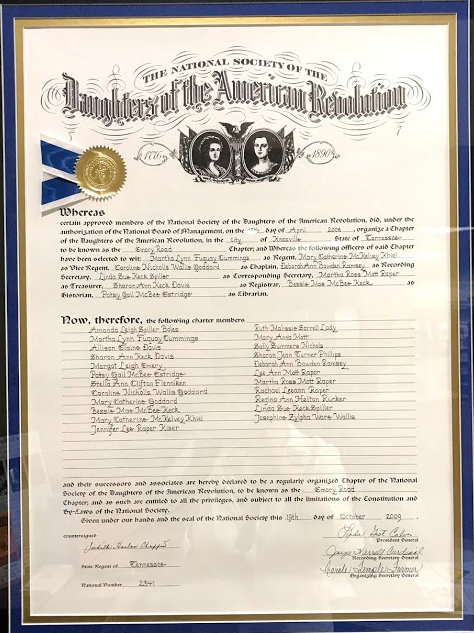Our Chapter History
In December 2007, plans were set in motion for a new vibrant, and active chapter. By April 2008, the Emory Road Chapter, NSDAR, was organized with eighteen members. Martha Fuquay Cummings was named organizing chapter regent. On October 25, 2009, a delightful chartering ceremony was held at the East Tennessee Historical Society.
Throughout the years, the chapter members have volunteered many hours of work for veterans by participating in pinning ceremonies, memorial events, and wreath-laying ceremonies. Also, the chapter has supported education by providing materials during Constitution Week and donating supplies to local schools and DAR schools.
The Emory Road Chapter, NSDAR, members are very active in both national and state committees. One of the first active committees was the Junior American Citizens, and it continues to be a very successful program. Students in area schools participate in contests. Chapter members visit the local veterans’ home and distribute greeting cards and participate in the veterans’ parade. Historic preservation awards have also been presented to individuals who have dedicated their time and effort to the preservation of historic sites and in preserving history through books and media.

Emory Road Chapter, NSDAR, Charter Members
- Martha Lynn Fuquay Cummings, Organizing Chapter Regent
- Amanda Leigh Spiller Boles
- Margot Leigh Emery
- Mary Catherine Goddard
- Jennifer Raper Kiser
- Sharon Turner Phillips
- Martha Ross Mott Raper
- Josephine Zylha Ware Wallis
- Allison Elaine Davis
- Patsy Gail McBee Keck
- Ruth Malissie Sorrell Lady
- Deborah Bowden Ramsey
- Rachel Leann Raper
- Sharon Ann Keck Davis
- Caroline Wallis Goddard
- Mary Catherine McKelvey Khiel
- Mary Anna Mott
- Lee Ann Mott Raper
- Linda Sue Keck Spiller
The History of the Emory Road
Emory Road Chapter, NSDAR, was named after one of the most well-known roads in Knox County. The original “Emery Road” followed closely some sections of an old Indian trail from the area now known as East Tennessee to what is now Middle Tennessee. More direct and shorter than the Wilderness Road, it would accommodate the expected increases in immigration as American Revolutionary War veterans claimed their land warrants. Several forts, such as Sawyers Fort and Fort Reynolds, were erected along Emory Road.
